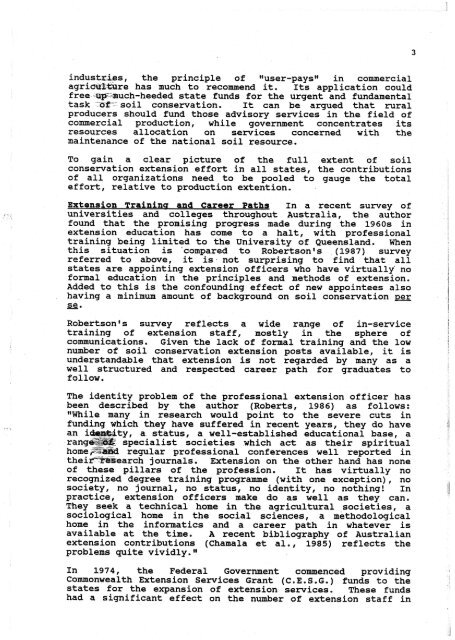soil-conservation-people-religion-and-land.pdf - South West NRM
soil-conservation-people-religion-and-land.pdf - South West NRM
soil-conservation-people-religion-and-land.pdf - South West NRM
Create successful ePaper yourself
Turn your PDF publications into a flip-book with our unique Google optimized e-Paper software.
industries, the principle of lquser-paysw in commercial<br />
agricuZ%%re has much to recommend it. Its application could<br />
free+=-much-heeded state funds for the urgent <strong>and</strong> fundamental<br />
task '3-CT <strong>soil</strong> <strong>conservation</strong>. It can be argued that rural<br />
producers should fund those advisory services in the field of<br />
commercial production, while government concentrates its<br />
resources allocation on services concerned with the<br />
maintenance of the national <strong>soil</strong> resource.<br />
To gain a clear picture of the full extent of <strong>soil</strong><br />
consemation extension effort in all states, the contributions<br />
of all organizations need to be pooled to gauge the total<br />
effort, relative to production extention.<br />
Extension Trainincr <strong>and</strong> Career Paths In a recent sunrey of<br />
universities <strong>and</strong> colleges throughout Australia, the author<br />
found that the promising progress made during the 1960s in<br />
extension education has come to a halt, with professional<br />
training being limited to the University of Queensl<strong>and</strong>. When<br />
this situation is 'compared to Robertson's (1987) survey<br />
referred to above, it is. not surprising to find that all<br />
states are appointing extension officers who have virtually no<br />
formal education in the principles <strong>and</strong> methods of extension.<br />
Added to this is the confounding effect of new appointees also<br />
having a minimum amount of background on <strong>soil</strong> <strong>conservation</strong> per<br />
- sea<br />
Robertson's survey reflects a wide range of in-service<br />
training of extension staff, mostly in the sphere of<br />
communications. Given the lack of formal training <strong>and</strong> the low<br />
number of <strong>soil</strong> <strong>conservation</strong> extension posts available, it is<br />
underst<strong>and</strong>able that extension is not regarded by many as a<br />
well structured <strong>and</strong> respected career path for graduates to<br />
follow.<br />
The identity problem of the professional extension officer has<br />
been described by the author (Roberts, 1986) as follows:<br />
While many in research would point to the severe cuts in<br />
funding which they have suffered in recent years, they do have<br />
ty, a status, a well-established educational base, a<br />
specialist societies which act as their spiritual<br />
regular professional conferences well reported in<br />
their3aSearch journals. Extension on the other h<strong>and</strong> has none<br />
of these pillars of the profession. It has virtually no<br />
recognized degree training programme (with one exception), no<br />
society, no journal, no status, no identity, no nothing! In<br />
practice, extension officers make do as well as they can.<br />
They seek a technical home in the agricultural societies, a<br />
sociological home in the social sciences, a methodological<br />
home in the informatics <strong>and</strong> a career path in whatever is<br />
available at the time. A recent bibliography of Australian<br />
extension contributions (Chamala et al., 1985) reflects the<br />
problems quite vividly.<br />
In 1974, the Federal Government commenced providing<br />
Commonwealth Extension Services Grant (CaEaSaGa) funds to the<br />
states for the expansion of extension services. These funds<br />
had a significant effect on the n er of extension staff in
















